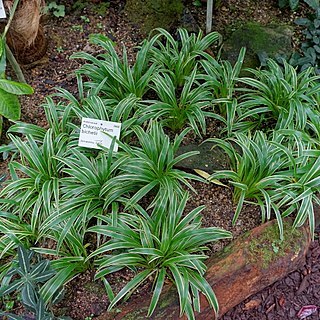Tufts c. 2 cm wide at base; tubers usually present along roots, fusiform, 2-10 cm long. Leaves 12-40 cm long; lamina 2-8 mm wide; veins prominent. Inflorescence 10-35 cm long, ±arching-ascending, axis simple or 1-to many-branched; clusters 2-6-flowered, flowers mostly aborting; bracts ovate, attenuate, 1.5-8 mm long; pedicels 2-8 mm long, spreading. Perianth green to white; segments 2.5-4 mm long, hooded, 3-5-nerved. Sepals linear. Petals elliptic. Filaments 1.5-2.5 mm long; anthers c. 0.5 mm long. Ovary c. 1.5 mm long; style c. 1 mm long. Capsule 4-6 mm long; pedicel to 20 mm long. Seeds strongly incurved, becoming ±hemispherical, 0.8-3 mm wide; testa minutely aculeate, red-brown, glossy.
Rhizome short, inconspicuous. Roots clustered. Leaves subdistichous, sessile, grasslike, usually falcate, 10--20(--37) cm × 3--6 mm, glabrous. Scape usually 2 or 3, erect or arching, 10--20 cm. Raceme sometimes few branched and paniculate, several to many flowered; bracts narrowly deltoid to lanceolate, very small. Flowers solitary or paired; pedicel 2--5 mm, articulate proximally. Tepals greenish white, ovate, 2--3 × ca. 1 mm, closely 3-veined. Stamens shorter than tepals; anthers subglobose, ca. 0.4 mm, 1/3--1/2 as long as filaments. Capsule broadly globose to broadly obcordate, ca. 3 × 5(--7.5) mm; seeds usually 1 per valve. Fl. and fr. Oct--Apr. 2 n = 14, 16, 32.
A grass-like plant. It forms a ground cover. It grows 10 cm tall. The roots have tuberous swellings. These are 2-4 cm long by 1 mm wide. The leaves are 10-25 cm long by 0.8 cm wide. The flower stalks are 10-20 cm long with 2 flowers are the nodes.
Inflorescences usually curved
A small herb of shady places
Flowers white.

